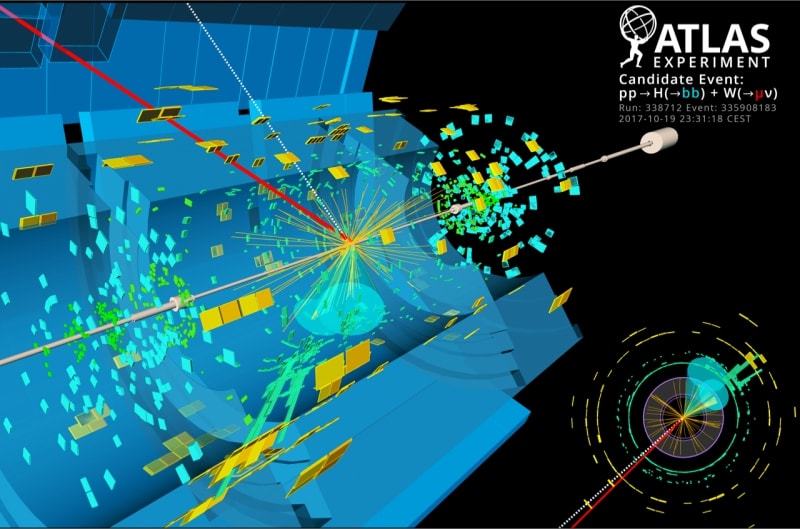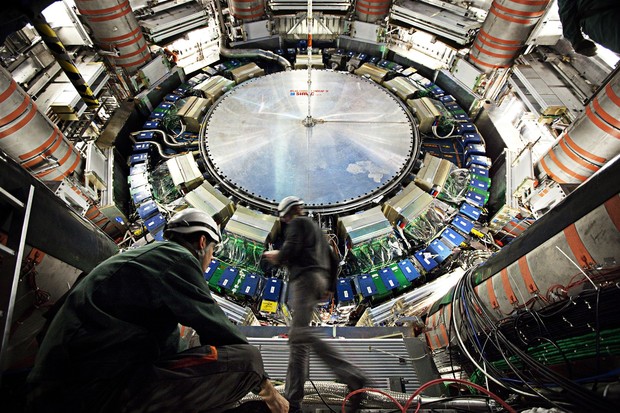Here's What Happens When a Higgs Boson Dies — and What It Means for Particle Physics

Six years after discovering the Higgs boson, physicists have observed how the particle decays — a monumental contribution to scientists' understanding of the Standard Model of particle physics and the universe at large, study researchers said.
Excitement swirled in the physics community when, in 2012, physicists discovered the Higgs boson, an elementary particle predicted by the Standard Model that relates to how objects have mass. But this discovery didn't mark the end of Higgs boson exploration. In addition to predicting the existence of Higgs boson particles, the Standard Model posits that 60 percent of the time, a Higgs boson particle will decay into fundamental particles called bottom quarks (b quarks).
In research presented yesterday (Aug. 28) at CERN, the ATLAS and CMS collaborations at the LHC at CERN say they have observed the Higgs boson decay into b quarks. The finding provides major support for the Standard Model, which has many implications for how we understand the world and the universe. "The Higgs boson is the least well-known and in many ways the most baffling particle in the standard model. Observing its decay to bottom quarks is a major milestone in our understanding of its properties," Jessie Shelton, a high-energy particle physicist at the University of Illinois who was not involved in this research, said in an email to Space.com. [In Photos: Universe's Expansion Revealed by Quasars & Cosmic Lenses]
Higgs boson particles don't live very long. "You'll never hold a Higgs boson in your hand," James Beacham, an experimental high-energy particle physicist working with the ATLAS collaboration at the Large Hadron Collider (LHC) at CERN (the European Organization for Nuclear Research) in Switzerland, said to Space.com. But, although the Standard Model predicts what happens to the Higgs boson when it dies, until now, researchers hadn't observed the particle decay into b quarks, Beacham said.
Although observing the Higgs boson decay might not garner as much attention as the discovery of the particle itself, which was awarded the 2013 Nobel Prize in physics, it is a colossal victory, the researchers said. But the work didn't come easily. To create b quarks, physicists essentially smash protons together. A lot of background "noise" results from this process, and b quarks "are almost impossible to tease out from background" "fuzz," or sprays of lighter particles known as jets, Beacham said.
Additionally, ATLAS and CMS are separate detectors, so the collaborations working on each one must make and confirm these observations separately for it to "count."

The findings are another big step along the journey to better understand the Higgs boson and our universe. And each new discovery or observation, like the discovery of the Higgs boson, has the potential to give way to new questions and experiments. "First [you] discover the thing," Beacham said about the Higgs boson. "Then, you want to measure everything about it."
Additionally, this work represents "a significant landmark in our tests of the Standard Model," Shelton said. "The Higgs' main job in the Standard Model is to give masses to the matter fermions and the weak force carriers," Shelton continued, "observing this decay, then, is our first direct piece of evidence that the Higgs boson gives masses to [down-type] quarks as the Standard Model predicts. Observing this decay mode also leaves less room for potential undiscovered particles to contribute to fermion masses."
Get the Space.com Newsletter
Breaking space news, the latest updates on rocket launches, skywatching events and more!
In confirming that this particle does, in fact, decay into b quarks, these physicists have shown that the Higgs field, the field behind Higgs boson particles described by Beacham as the "invisible jelly that permeates all of space," gives b quarks mass. The Higgs field uses the Higgs boson to interact with other particles, like the b quark, and give them mass.
Experiments like these allow physicists to not only validate what the Standard Model predicts about the Higgs boson and b quarks but also challenge what the Standard Model predicts. "So far, the Standard Model is continually winning," Beacham said. "[But] if we find evidence that it's not so standard," Beacham continued — if we find things like "extra quarks, weirdo things like vector-like quarks, leptoquarks, dark matter" — then we might also find a totally new understanding of how our universe works.
Email Chelsea Gohd at cgohd@space.com or follow her @chelsea_gohd. Follow us @Spacedotcom, Facebook and Google+. Original article on Space.com.
Join our Space Forums to keep talking space on the latest missions, night sky and more! And if you have a news tip, correction or comment, let us know at: community@space.com.

Chelsea “Foxanne” Gohd joined Space.com in 2018 and is now a Senior Writer, writing about everything from climate change to planetary science and human spaceflight in both articles and on-camera in videos. With a degree in Public Health and biological sciences, Chelsea has written and worked for institutions including the American Museum of Natural History, Scientific American, Discover Magazine Blog, Astronomy Magazine and Live Science. When not writing, editing or filming something space-y, Chelsea "Foxanne" Gohd is writing music and performing as Foxanne, even launching a song to space in 2021 with Inspiration4. You can follow her on Twitter @chelsea_gohd and @foxannemusic.









